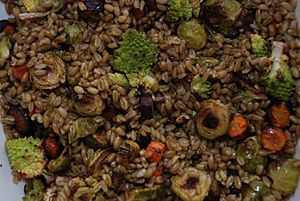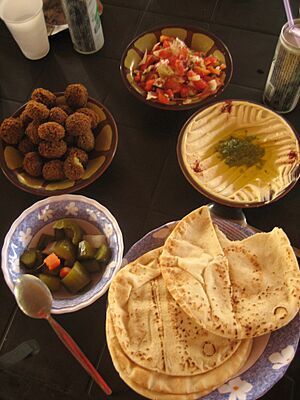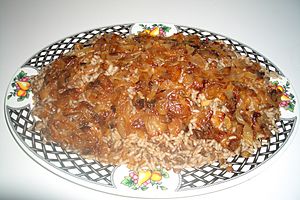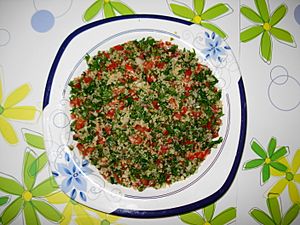Jordanian cuisine facts for kids
Jordanian cuisine is a type of Middle Eastern cuisine. It includes traditional foods from Jordan that have changed over hundreds of years.
People in Jordan use many ways to cook their food. They bake, fry, grill, and stuff vegetables like zucchini and eggplant. Meat is very important in Jordanian cooking. The most common meats are lamb, beef, and chicken. Sometimes, people also eat goat or camel meat. Jordanians also like to roast foods or cook them with special sauces.
Rice is a big part of Jordanian meals. It often comes with main dishes. There are also many dishes where rice is the main ingredient, like Maqloubah.
Jordan grows a lot of olives, so olive oil is the main cooking oil. Common flavors in Jordan come from herbs, garlic, onion, tomato sauce, and lemon.
The spice mix called za'atar has a local herb called sumac. This herb grows wild in Jordan and is very important to Jordanian and other Middle Eastern foods.
Yogurt is often served with meals and used in cooking. A special type of dried yogurt called jameed is unique to Jordan. It is the main ingredient in mansaf, which is Jordan's national dish. Mansaf is a symbol of being kind and generous in Jordanian culture.
Another famous meat dish is zarb. It is very popular in areas where Bedouin tribes live, like Petra and Wadi Rum. Tourists often get to try it there. Zarb is cooked in an underground oven called a taboon. It is a special meal with meat (usually chicken and lamb) and vegetables like zucchini, eggplant, carrots, and potatoes. It is served with rice and small dishes called mezze, like tabbouleh salad.
Some well-known foods that are popular snacks in Jordan include hummus and falafel. Hummus is a creamy dip made from chickpeas mixed with tahini, lemon, and garlic. Falafel are deep-fried balls or patties made from ground chickpeas.
A typical mezze (small dishes) might include kibbeh, labaneh (strained yogurt), baba ghanoush, tabbouleh, olives, and pickles. Bread, rice, freekeh (green wheat), and bulgur (cracked wheat) are also important in Jordanian cooking.
Popular sweets include baklava, knafeh, halva, and qatayef. Qatayef is a special dish made for Ramadan. Fresh fruits like watermelons, figs, and prickly pears are served in the summer.
Turkish coffee and tea with mint or sage are found almost everywhere in Jordan. Arabic coffee is usually served for more formal events.
Contents
Food Culture and Traditions in Jordan
Jordanian food is part of Levantine cuisine. It shares many things with food from Lebanon, Palestine, and Syria. Sometimes there are small local differences. Jordanian food is also shaped by its history with Turkish cuisine and the old Ottoman Empire. Plus, it's influenced by groups who have made Jordan their home, like Armenians, Circassians, Iraqis, Palestinians, and Syrians.
Food is a very important part of Jordanian culture. In villages, meals are a time for the whole family to gather. Jordanians also use food to show how welcoming and generous they are. They proudly serve food to family, friends, and guests in their homes, even if they don't have much. If you get a "Jordanian invitation," it means you don't need to bring anything, but you should eat everything!
Special events in Jordan are celebrated with lots of Jordanian dishes. Things like weddings, the birth of a child, funerals, birthdays, and holidays like Ramadan and Jordan's Independence Day all involve serving wonderful food to guests. To celebrate a baby's birth, people often serve karawiya, a pudding flavored with caraway.
Popular Jordanian Dishes
Main Meals

| Name | What it is |
|---|---|
| Al-rashoof (الرشوف) | A winter meal with coarse wheat flour, lentils, and yogurt. It's popular in northern Jordan. |
| Athan al-shayeb (أذان الشايب) | Means "the ears of the old gray-haired man." These are pasta pockets like ravioli, stuffed with ground beef and spices. They are cooked in jameed (dried yogurt sauce) and served hot. It's also called shishbarak. |
| Bamya (بامية) | Okra cooked with tomato sauce and onions, served with rice and lamb. |
| Burghul ahmar (البرغل الأحمر) | Bulgur (cracked wheat) cooked in tomato sauce and served with poultry. |
| Burghul bzeit (برغل بالزيت) | Bulgur cooked in olive oil and served with poultry. |
| Fasoulya beyda (الفاصوليا البيضاء) | White beans cooked in tomato sauce and served with rice. |
| Fasoulya khadra (فاصوليا خضراء) | Green beans cooked in tomato sauce and served with rice. |
| Fatteh (الفتّه ) | Layers of khubz (bread) topped with strained yogurt, steamed chickpeas, and olive oil, all mixed together. |
| Freekeh (فريكة) | Served with chicken or meat. The meat is fried, then cooked with water, salt, and cinnamon. Dried coriander and freekeh are added and cooked. |
| Galayet bandora (قلاية بندورة) | Tomatoes fried and stewed with onions, olive oil, salt, and hot peppers. It can be served with rice but is often eaten with bread. |
| Haneeth (محشوة الضأن الرضيع) | A popular, hearty dish in Jordan. It's roasted lamb stuffed with rice, chopped onions, nuts, and raisins. |
| Kabsa (الكبسة) | A mix of spices, rice (often basmati), meat, and vegetables. |
| Kebab (كباب) | Roasted or grilled meat, also called mashawi. It can be a mix of barbecued meats like kebab and shish taouk. |
| Kofta b'bandoora (كفتة بالبندورة) | Spiced, ground meat baked in tomato sauce and served with rice. |
| Kofta b'tahini (كفتة الطحينة) | Spiced, ground meat baked in a sauce of tahini, topped with thin potato slices and pine nuts. Served with rice. |
| Kousa mahshi (كوسا محشي) | Zucchini stuffed with rice and minced meat. Usually served with chicken and wara' aynab (also called dawali). |
| Maftul (مفتول) | Large couscous-like balls, chickpeas, and chicken pieces cooked in chicken broth. |
| Malfuf (ملفوف) | Rice and minced meat rolled in cabbage leaves. |
| Mansaf (المنسف) | The national dish of Jordan. It's lamb cooked in a sauce of dried yogurt called jameed, served with rice or bulgur. |
| Maqluba/Magluba (مقلوبة) | A casserole with layers of rice, vegetables, and meat. After cooking, the pot is flipped upside-down onto the plate. That's why it's called maqluba, meaning "upside-down." |
| Mujaddara (مجدرة) | A casserole of lentils and rice, topped with roasted onions. |
| Mulukhiyah (ملوخية) | The leaves of the Corchorus plant used as a vegetable. |
| Musakhan (مسخّن) | Roasted chicken baked with onions, sumac, allspice, saffron, and fried pine nuts. Served over taboon bread. Also known as muhammar. |
| Musaqa'h (مسقعة) | Different versions of this Mediterranean dish are cooked in Jordan. |
| Warag aynab (sarma) (ورق العنب) | Grape leaves filled with seasoned vegetables, meat, and rice, cooked with olive oil. Sometimes called dawali. |
| Zarb (زارب) | A Bedouin barbecue. Meat and vegetables are cooked in a large underground pit. |
Small Dishes (Mezze)
Mezze is the most common way to eat in Jordan. It means eating many small plates, salads, and appetizers. People often dip and scoop with bread. Mezze dishes are usually served before the main meal.
A typical Jordanian mezze might include:
| Name | What it is |
|---|---|
| Arab salad (سلطة عربية) | A mix of different vegetables and spices. |
| Baba ghanoush (بابا غنوج) | Eggplant mixed with onions, tomatoes, olive oil, and different seasonings. |
| Bagdonsyyeh (بقدونسية) | Parsley mixed with tahini and lemon juice. Often served with seafood. |
| Falafel (فلافل) | Fried balls of chickpea flour and Middle Eastern spices. They are dipped in almost every mezze, especially hummus. Jordanian falafel balls are usually smaller. |
| Fattoush (فتوش) | A salad made from toasted or fried pita bread mixed with greens and other vegetables like lettuce, radish, and tomato. |
| Ful medames (فول مدمس) | Crushed fava beans served with toppings like olive oil, lemon juice, parsley, chili pepper, and sumac. |
| Halloumi (حلوم) | A semi-soft white cheese. It's not as salty or crumbly as feta cheese, but similar. |
| Hummus (الحمص) | Chickpeas boiled and blended until smooth with tahini paste, garlic, olive oil, lemon juice, and sometimes a little parsley on top. |
| Khobbeizeh (خبيزه) | Little mallow cooked with olive oil. |
| Kibbeh (كبة) | Seasoned, minced meat covered in a crust of bulgur (cracked wheat), then fried. It's shaped like an American football. |
| Kibbeh labaniyyeh (كبه لبنيه) | A mix of minced meat and bulgur, similar to regular kubbeh, but boiled with Jordanian jameed. |
| Kibbeh nayyeh (كبة نية) | A mix of minced meat and bulgur, similar to regular kubbeh, but the meat is served raw. |
| Labaneh jarashiyyeh (لبنه جرشيه) | Literally "labaneh from Jerash". This creamy yogurt is so thick you can spread it on flatbread to make a sandwich. |
| Makdous/Magdous (مكدوس) | Stuffed pickled eggplant, said to make you hungry. |
| Manakish/ Managish (مناقيش) | Flatbread dough usually topped with olive oil and za’atar spice mix. Other types might have cheese or ground meat, called sfiha. |
| Moutabal (متبل) | Roasted, mashed potato or eggplant with garlic. |
| Olive oil (زيت الزيتون) | One of the most important parts of Jordanian food. For breakfast, Jordanians dip flatbread into olive oil, then into za'atar. |
| Pickled vegetables (خضروات مخللة) | Jordanians love pickled foods like carrots, radishes, cucumbers, and cauliflower. Almost every mezze has a plate of these for a tangy taste. |
| Samosa (ساموسا) | Fried dough balls stuffed with meat, pine nuts, and onions. |
| Tabbouleh (تبولة) | A vegetarian dish made of tomatoes, finely chopped parsley, mint, bulgur, and onion. It's seasoned with olive oil, lemon juice, and salt. Some versions add garlic or lettuce, or use couscous instead of bulgur. |
| Tursu or (Mokhalal) (طرشي) | Different vegetables soaked in water and salt for a week. Examples are cucumber, cabbage, eggplant flower, carrot, radish, onion, lemon, olives, chili, and beans. |
| Warag aynab (أوراق العنب) | Vine leaves filled with seasoned vegetables, meat, and rice. |
| Yalanji (يلنجي) | A dish of vine leaves mainly stuffed with rice. |
| Za'atar (زعتر) | A mix of thyme and sesame seeds. Oregano, sage, or sumac can also be added. |
| Zaitun (زيتون) | Literally olive. |
Fresh Salads
| Name | What it is |
|---|---|
| Arab salad (سلطة العربية) | A salad with tomato, cucumber, onion, mint, olive oil, and lemon juice. |
| Babba ghanoush (بابا غنوج) | Roasted eggplant, cut into pieces and mixed with tomatoes and onions. |
| Fattoush (فتوش) | Chopped vegetable salad (tomato, cucumber, radish, etc.) mixed with dry or fried flatbread pieces. Seasoned with olive oil, lemon juice, and sumac. |
| Olive salad (سلطة الزيتون) | Olives cut with carrots, green pepper, and chili, dressed with olive oil. |
| Rocket salad (سلطة جرجير) | Large rucola (arugula, rocket) leaves in Jordan, mixed with olive oil and lemon. |
| Tabbouleh (تبولة) | Finely chopped parsley and mint mixed with bulgur, tomatoes, and onion. Seasoned with olive oil and lemon juice. |
Warm Soups
In Jordan, meals usually start with soups. Jordanian soups are often named after their main ingredient:
| Name | What it is |
|---|---|
| Adas soup (شوربة عدس) | Served hot. It's made from mashed brown, red, or green lentils with chicken or meat broth and different spices. Other ingredients can include vegetables like carrots, potatoes, celery, parsley, and onion. |
| Freekeh soup (شوربة فريكة) | Served hot. This soup has Freekeh (green wheat), chicken or meat broth, and different spices. |
Sandwiches
| Name | What it is |
|---|---|
| Ara'yes (العرايس) | Means "bride." These are spicy minced meat-filled flatbread sandwiches baked in the oven. |
| Falafel (فلافل) | Fresh bread filled or wrapped with falafel, hummus, tomato, and pickles. |
| Managish (مناقيش) | Taboon bread topped with za'atar and olive oil. |
| Mo'ajanat (معجنات) | Pies filled with cheese, spinach, za'atar, or beef. |
| Sambusak (سمبوسك) | Fried dough balls stuffed with cheese or meat with pine nuts and onions. |
| Sfiha (صفيحة) | Flatbread topped with ground beef and red peppers. |
| Shawarma (الشاورما) | Seasoned chicken, lamb, or beef cooked on a spinning spit. It's sliced and wrapped in flatbread, served with vegetables, tahini, and hot sauce. |
Breads
- Abud—a thick, unleavened traditional Bedouin flatbread. It's baked directly in a wood fire by burying it in ash and covering it with hot coals.
- Ka'ak (كعك)—a traditional Jordanian bread, usually made in a large leaf or ring shape and covered with sesame seeds.
- Karadeesh—a traditional Jordanian bread made from corn.
- Khubz (خبز, pita): This is a general term for bread, usually referring to pita bread with a pocket.
- Shrak—a traditional Bedouin bread, popular in Jordan. It's stretched very thin before being tossed onto a hot iron griddle called saj, which is shaped like an upside-down wok. Also known as markook.
- Taboon (خبز طابون)—a flatbread wrap used in many cuisines. It's traditionally baked in a tabun oven and eaten with different fillings. Also known as laffa bread, it's sold as street food, stuffed with hummus, falafel, or shaved meat.
Sweet Treats
- Baklava (بقلاوة)—a dessert made with thin layers of phyllo pastry filled with chopped nuts and soaked in honey or syrup.
- Halva (حلوى)—a Middle Eastern sweet made from sesame flour and milk mixed with other ingredients, often with pistachios.
- Knafeh (كُنافة)—a cheese pastry made of shredded phyllo dough soaked in a sugar syrup.
- Qatayef (قطايف)—a sweet dumpling stuffed with cream and pistachios. It's eaten during Ramadan.
- Warbat (وربات)—a pastry with thin layers of phyllo dough filled with custard. Often eaten during the month of Ramadan.
Drinks
- Arabic coffee (Qahwa sada, قهوة عربية)—usually made by Bedouins. It's ground, fire-roasted beans and cardamom, brewed thin and served in small, espresso-sized cups.
- Lime-mint juice—a refreshing drink made from lemon and mint.
- Qamar eddine (قمر الدين)—apricot juice, usually served in Ramadan.
- Sahlab (سحلب)—boiled milk with starch from Orchis tubers, topped with crushed coconut and cinnamon.
- Shaneeneh (شنينة)—a refreshing Jordanian drink made from salty-sour aged goat milk yogurt, served cold.
- Tamar hindi (تمر هندي)—a very popular sweet-and-sour Ramadan drink made with tamarind juice.
- Tea (شاي أسود)—usually black tea, often flavored with na'na (mint) or meramiyyeh (sage) with lots of sugar. Alghazaleen and Lipton are the most popular tea brands in Jordan.
- Turkish-style coffee (قهوة تركية)—much stronger than Arabic coffee. Water is heated in a long-handled metal cup, and the coffee grounds (and any sugar) are mixed in as it brews over a gas flame until bubbling.
See also
 In Spanish: Gastronomía de Jordania para niños
In Spanish: Gastronomía de Jordania para niños





